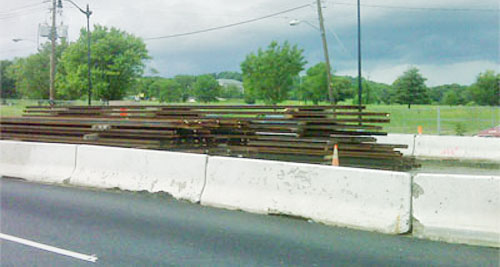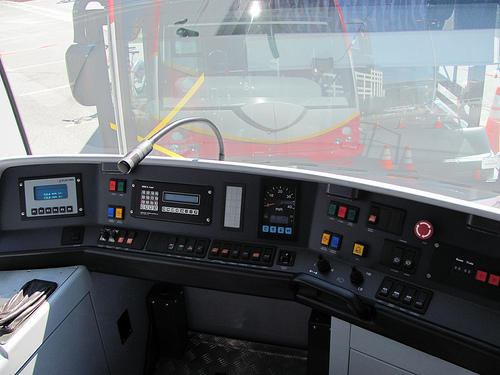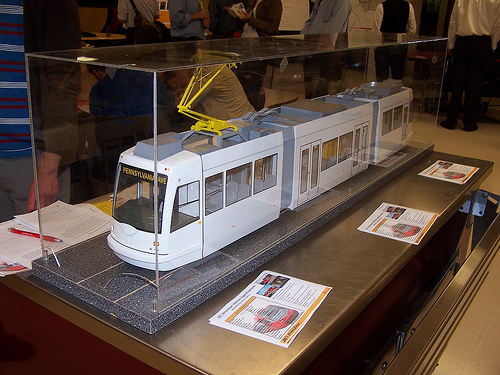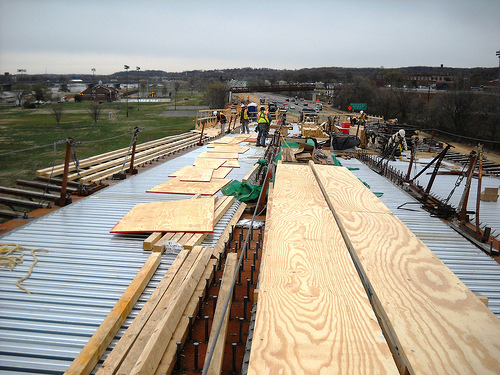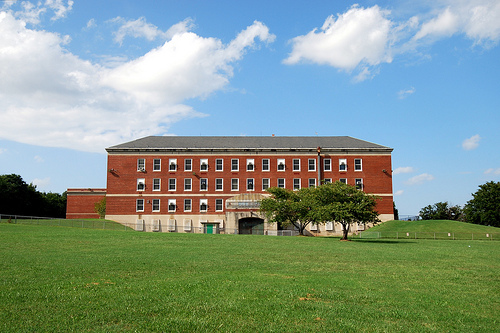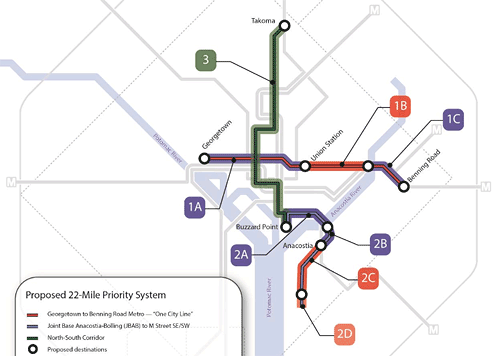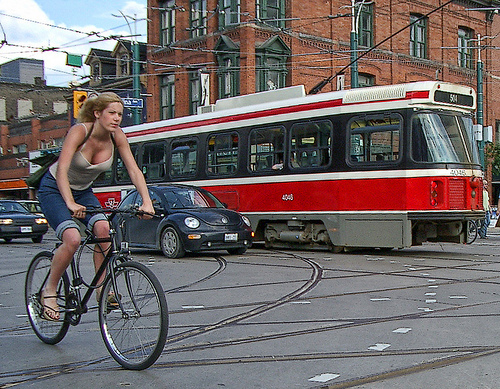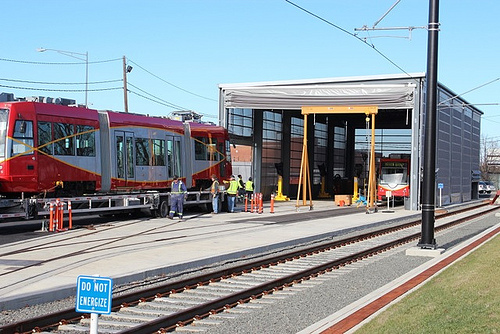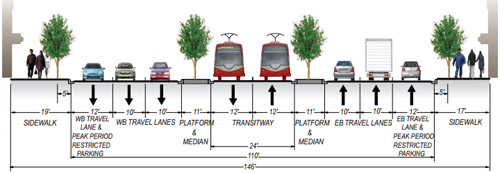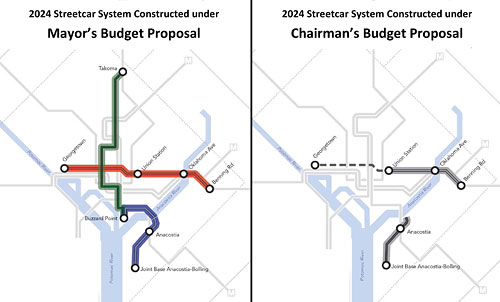The DC Streetcar starts service on Saturday. It took a wild ride to get here.
When DC’s H Street and Benning Road streetcar opens on February 27, it’ll run on rails that were first installed almost seven years earlier. We’ve been talking about this project since 2008, with hundreds of posts. The following is a little walk down memory lane to look at everything that’s happened.
Forty years after streetcars vanish, efforts begin to bring them back
Streetcars used to ply DC’s streets until 1962. In 1956, following a strike, Congress forced the streetcar’s operator to shut down all streetcars and replace them with buses.
But decades later, the Metro was under construction and rail transit was coming back. Metro wouldn’t serve all parts of the city, however. A 1997 long-range transportation plan from the Barry administration called for new streetcar lines, including on H Street and Benning Road.
In the early 2000s, the DC government was trying to find a way to get a streetcar system started cheaply. An unused CSX track that runs through Anacostia seemed like a great spot. DC jumped on a Portland streetcar contract in 2004 to purchase three Czech-made cars. But DC couldn’t get the rights to use the line, and the cars sat in the Czech Republic, unused.
2008: Anacostia? H Street? Both?
A political fight also was brewing in the DC Council about where to start the streetcar project. A line from Anacostia Metro to Bolling Air Force Base wouldn’t have served many people. DDOT agreed to plan a route through Historic Anacostia as well, but many residents were not enthusiastic. Meanwhile, H Street businesses, residents, and Councilmember Tommy Wells were eager for the line on H Street.
DC had recently finished designing several corridors around the city in a program called “Great Streets.” H Street and Benning Road, NE was one. Since a streetcar line was in the city’s plans, to avoid having to reconstruct the street a second time, the decision was made to install tracks during the project.
2009: DDOT gets serious about a streetcar, but questions remain
The streetscape program yielded visible progress, but many details of the streetcar itself were not yet worked out. Besides sticking rails in the ground, what exactly was DC going to build? Where would the streetcar turn around? Where would maintenance happen? And what would power the cars?
Gabe Klein, then head of DDOT, decided to make the project a much higher priority, and in late 2009, the administration followed through with a bold vision to build eight lines in all wards of DC. He also moved the three streetcars across the ocean from the Czech Republic.
At the time, officials estimated the whole system could be built in 7-10 years for a cost of $1.5 billion. Mostly, they planned to put them in mixed traffic rather than dedicated lanes, except for a few segments on Rhode Island Avenue, M Street SE, and K Street NW.
There were already some signs that DDOT wasn’t thinking everything through. WMATA sent a letter worrying that the platforms, high enough to roll right onto a streetcar, would be too high to board the X2 buses, which run along the same street. Would they conflict?
Unless you’ve got power
One of the big questions was how cars would get power. A law prohibited overhead wires in the L’Enfant city, including H Street NE. Some groups were gearing up to oppose the streetcar not based on its function, but based on the aesthetics of having any wires above the street.
While insisting that modern wires look much less intrusive than many of the old-fashioned ones in some cities, DDOT promised to look into wireless technology, especially hybrid approaches that could use some off-wire segments along curves (which require more wires) and across important view corridors. Groups like the Committee of 100 were pushing for a fully wireless approach, but experts said that was not feasible without major extra cost and maintenance headaches, at least not today.
2010: The Great Overhead Wire Battle
To get people excited about the project, in May 2010 DDOT brought the streetcar down to the parking lot that’s now CityCenterDC. People could touch the vehicle and climb on board. They could also see two other DDOT vehicles: a newer Circulator bus and a bicycle for the soon-to-be-launched Capital Bikeshare.
Opposition from the Committee of 100 and other groups continued. It focused on two streams: first, opposition to overhead wires; and second, an argument that there needed to be more planning before moving ahead. In retrospect, they were absolutely right on the second point, but the first one overshadowed it and unfortunately made the more prescient warnings less credible. May is the time the DC Council finishes its budget, and many chairs have unveiled a final budget late the night before the deadline for a final vote.
At 2 am on May 26, 2010, then-Chairman Vincent Gray, and also a candidate for mayor, cut the streetcar funding in his final budget. We and others sounded the alarm, and residents flooded Gray’s office with calls asking to restore the funding. By that afternoon, he had worked out a deal with councilmembers to do just that.
Gray always maintained that his move to cut streetcar funds wasn’t an attempt to kill the project outright, but stemmed from a belief that it needed more planning first. At a later campaign town hall, he said, “I support streetcars; let me make that clear. … We have a commitment” to build out a 37-mile system.
Soon after the budget fight, the council took a step to amend the overhead wire ban to allow wires on H Street (and elsewhere once the council approves a citywide streetcar plan and DDOT studies off-wire options). All councilmembers except Phil Mendelson cosponsored the bill. As Ken Archer explained to the council, beautiful historic cities like Prague have trams using wires and still maintain their historic charm.
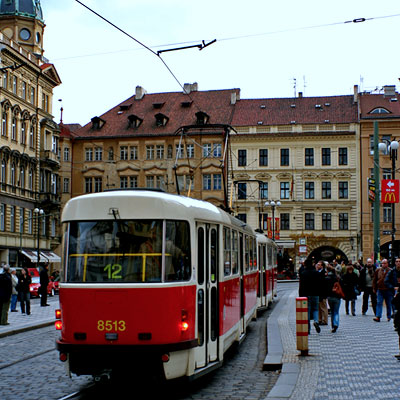
A streetcar wire in Prague. Photo by Isaac Wedlin on Flickr.
The National Capital Planning Commission wasn’t so excited about wires. Its chair, Preston Bryant, threatened to ask the federal government to reject grants to DC if the District continued with its efforts, and then followed through on his threat. DC officials called that “bureaucratic blackmail.” The Federal Transit Administration indeed rejected DC’s grant application, though sources said NCPC wasn’t the reason as the winners had been selected well before Bryant’s letter.
Planning and promises
In October 2010, DDOT released a more detailed streetcar plan that said:
- Service on the H Street/Benning Road line and in Anacostia (to start with, south of the Anacostia Metro) would start in March 2012
- A train would come every 10 minutes on H Street and every 15 in Anacostia
- Rides would cost $1
- There would be a proof-of-payment system instead of paying on board
- DDOT would buy three more streetcars in addition to the three it already had
In December, Gray, by that time mayor-elect, continued his support for the program in a budget proposal. His transition report, however, sharply criticized DDOT for mismanagement in a number of areas. His first official budget allocated $99 million to streetcars. Studies continued about how to route the streetcar through Historic Anacostia, but growing numbers of residents raised opposition to the project entirely.
2011-2012: Setbacks
In April 2011, the completion date for the H Street/Benning Road line slipped to “late 2012.” It wasn’t the last delay. The streetcar plan had long called for tracks on the local span of the new 11th Street bridge, then under construction, to get the streetcar over the Anacostia River. But in October 2011, the Federal Transit Administration blocked DDOT from installing tracks on the bridge. According to DDOT sources, the move was fine with the Federal Highway Administration, but FTA suddenly stepped in.
If it seems ironic that the federal government’s transit agency would be the one pushing against transit, it’s not a new refrain. Then-FTA administrator (now head of Seattle’s transit agency) Peter Rogoff argued FTA had little leeway, but many other transportation professionals privately argued they could have allowed it.
Another, even bigger hurdle popped up. Since the 2010 plans, DDOT had expected to put the Union Station stop and a maintenance yard under the “Hopscotch Bridge” which carries H Street over the railroad tracks. One property owner didn’t want to go along, but DDOT officials kept predicting they could work out all necessary approvals.
That didn’t happen. Instead, Amtrak rejected the concept because it wanted to use the space for other purposes. (The next year, it released a master plan for Union Station that used that passageway as a concourse.) By early 2012, there had been procurement problems that meant DC would almost surely not have the 3 extra streetcars promised, meaning not enough to run at 10-minute headways.
In mid-2012, Councilmember Marion Barry tried to block another contract for the H Street line. Mayor Gray’s commitment didn’t wane, however; he budgeted $237 million over six years to construct multiple streetcar lines.
Spinning wheels on Spingarn
DDOT had been planning a maintenance facility on the Spingarn High School campus, but that had been a longer-term piece of the puzzle; with the area under the bridge unavailable, this was now blocking further progress. Nearby residents also asked to designate Spingarn as a historic landmark, forcing any plans to go through far more extensive historic review.
Then-DDOT Director Terry Bellamy said this would delay the project further; by now, it was delayed to late 2013 at the earliest. It also had become clear to many by this time that DDOT’s claims were not credible. DDOT had proposed the underpass maintenance yard idea without having buy-in and then couldn’t get it. It had planned tracks on the 11th Street Bridge and didn’t get those. Now, it hadn’t started working on Spingarn nearly far enough ahead of time, and like too many other streetcar pieces, plans for the maintenance facility weren’t publicly available at first (and when they were turned out to be meh until later getting better).
2013: Will it open?
Studies also continued for planning how to extend the line east from Oklahoma Avenue over the Anacostia River and west to Georgetown. Testing on H Street hadn’t even begun, but DDOT officials said that could happen in late 2013. They also started talking about a 22-mile “priority system” of three lines: east-west from Georgetown to Benning Road, from Anacostia to Buzzard Point, and from Buzzard Point to Takoma.
Even though it looked iffy, Mayor Gray kept promising streetcars would run in 2013. He also increased the budget to $400 million to pay for the line to go all the way to Georgetown, build the Anacostia line, and study the other lines in the 22-mile system.
One issue that had been brewing: How to make the area safe for people on bikes. Bicycle wheels can get stuck in streetcar tracks, and for a brief time incorrectly-installed grates even increased the danger. “Bike sneaks” and other design strategies can help cyclists stay safe.
The most important thing was to give cyclists another way to travel east-west, which DDOT did by designing and building bike lanes so people could ride two ways on G and I streets, parallel to H.
By October, DC officials admitted the streetcar wouldn’t run in 2013. Testing would start in December 2013. This was far from the only broken promise by DDOT under Bellamy’s leadership, which developed a reputation for being unable to deliver on its commitments.
Streetcar wires started appearing in November and the first vehicle arrived in December.
2014: The public-private partnership that wasn’t
The Gray Administration also devised a strategy to significantly speed up construction: Find a contractor who could design, build, operate, and maintain (DBOM) the streetcar. They hoped an organization with more expertise could get things done without all the delays that had come thus far.
Gray proposed a major, ongoing revenue source to fund the succession of lines, by allocating a quarter of new tax revenue that comes in above the base estimate for Fiscal Year 2015. That would have given the program an estimated $800 million over five years. A team started working on studies for the line on or near Georgia Avenue, and we pushed for dedicated lanes for this line. DDOT had already agreed to build dedicated lanes on K Street.
Challengers to Mayor Gray criticized his administration’s progress and the repeated delays.
On April Fool’s Day 2014, DC had its primary, and Gray lost his bid for renomination. His budget plan also went down the next month, as Chairman Phil Mendelson, again near the deadline (but not in the middle of the night), took much of the money away for tax cuts. He did, however, leave $400 million over five years, which the Gray administration said wasn’t even enough to pay for the segment west to Georgetown. Mendelson disputed that allegation, and battling budget analysts left many confused about what, exactly, was still being funded.
But the bigger problem was that DDOT had lost much of its credibility on the streetcar program from all of these delays, broken promises, and cover-ups over setbacks. Residents who had excitedly defended the program in 2010 were not ready to stick up for it in 2014.
Soon after, it became clear even opening in 2014 was unlikely, though the Gray Administration, as it had in 2013, kept promising service by the end of 2014. “Simulated service,” where the streetcars run as if they’re really operating with passengers to ensure they are safe, started in the fall. There was just barely enough time to launch service before New Year’s Day if the fire department signed off on the safety plans quickly. It didn’t.
2015: Reboot
A new administration brought in new leadership. Leif Dormsjo, the new head of DDOT, said he’d stop making promises until they could actually keep them. In fact, Dormsjo said he wasn’t totally certain the line would ever open. He brought in a team of experts from the American Public Transportation Association to evaluate the line. Their report concluded that it could indeed open, and Mayor Bowser promised to finish the line from Georgetown to either Minnesota Avenue or Benning Road Metro.
Oh, remember wires? The ones on H Street weren’t destroying the neighborhood, but DDOT did start planning for wireless operation across major intersections with state avenues, the Mall, and so on.
APTA’s report identified 33 fixes to make to the streetcar line, and DDOT got going on those. By July, it had finished 12. Dormsjo brought in a team of experts who had actually launched streetcars in other cities to get this project over the finish line.
We didn’t hear a lot about the streetcar in late 2015, but DDOT was working on fixing remaining problems with the line. Officials were also trying to get the fire department to sign off on safety plans.
2016: It’s time
DDOT restarted “simulated service” at the end of 2015 and even announced the streetcar would close during the “Snowzilla” storm, in part to show safety officials how the line would handle a storm like this. The fire department ultimately gave its consent to open the line, and now it’s scheduled to open on February 27.
This will be the first time most people will be able to get on a DC Streetcar since May 2010 and the first time they can while the vehicle is in motion. There have been a lot of claims about the streetcar, pro and con, and riding it will finally give people a chance to decide based on real experience.
After that, DC will have to decide what to do about the other proposed lines and studies. DDOT will have to finish studies about extending the H Street/Benning Road line east and west, and decide what to do with the studies in limbo in Anacostia and Georgia Avenue.
One thing is for sure: It’ll be great to have this sordid saga of delays and broken promises in the past.


